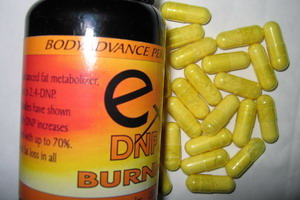 Dinitrophenol is used commercially mainly in scientific research and manufacturing industry. It was used at a time to make dyes, other products used in organic chemistry and processing products of wood. It has also been used to manufacture products to develop photographs, explosives and pesticides.
Dinitrophenol is used commercially mainly in scientific research and manufacturing industry. It was used at a time to make dyes, other products used in organic chemistry and processing products of wood. It has also been used to manufacture products to develop photographs, explosives and pesticides.
Pharmacological action
In living cells, dinitrophenol acts as a carrier of protons (ionophores), an agent that can transport protons (hydrogen ions) across biological membranes. It annoys the Proton gradient in mitochondria and chloroplast membranes and causes the collapse of the electrochemical gradient that the cell uses to produce chemical energy of most molecules of ATP. Instead of producing ATP, the energy of the Proton gradient is lost in heat. Cells compensate the decrease in yield of ATP by further oxidizing the stored form of carbohydrate and fat reserves.
Use as a weight loss treatment
The Dinitrophénom has been used extensively in the 1930s in diet pills after Cutting and Tainter at Stanford University have made their first study report on the ability of the drug to greatly increase their metabolic activity. Dinitrophenol acts as carrier of protons in the mitochondrial membrane, inhibiting the ATP oxidative phosphorylation and making less efficient energy production. Indeed, some of the energy that is normally produced from cellular respiration is wasted in heat. This lack of effectiveness is proportional to the dose of dinitrophenol is absorbed. Thus, as the dose increases, energy production becomes less effective, the metabolism is activated (more fat is burned), to compensate inefficiency and meet energy demand. Interestingly, the factor limiting more than increasing the dose of dinitrophenol is not the lack of energy production by the ATP, but rather an excessive increase in body temperature due to the heat. As a result, an overdose of dinitrophenol will cause a fatal fever. The dangerous side effects and in particular the cataracts developed led quickly to the prohibition of dinitrophenol to United States in the year 1938. Dinitrophenol however continues to be used by some bodybuilders and athletes to lose body fat quickly. Fatal overdoses are rare, but they are still reported occasionally. A German died after ingesting the DNP.
While dinitrophenol is considered by many as too dangerous for human use, its mechanism of action remains the object of study as approach a potential treatment for obesity. Currently, the research is focused on protein inhibitricess present naturally in humans.
It is a fungicide which has demonstrated its effectiveness for the treatment of wood and papier(il_atténue_le_noircissement_provoqué_par_les_champignons) pulp bleaching.
Because of the harmfulness of the product to man and the environment, the uses of these compounds are severely regulated. In France the Decree of 7 July 1994 prohibits the placing on the market of product containing more than 0.1%, however exceptions for including:
- For the preservation of wood for some uses (are excluded the lumber used in the manufacture of furniture or food packaging)
- For the impregnation of fibres and textiles not intended for clothing or furniture.
- As a synthesis or processing in industrial processes.
- For the treatment of buildings of historic and cultural interest in situ (authorized on a case by case).
Toxicokinetics
- Penetration in the body is both respiratory and skin (the dermal route is predominant)
- ECV has been set at 0.5 mg/m3
Human toxicity
Aerosols are irritating to the eyes, nose and upper airway. Solutions have an irritating action on the skin, they can cause up to a blistering burns.
Severe cases of poisoning that can go up to a fatal outcome were observed.
- Onset of headache, sweating, hyperthermia, tachycardia, dyspnea.
- Signs of irritation of the Mucosa, liver and kidney.
- In case severe hyperthermia and convulsive coma with hepatic cytolysis.





















